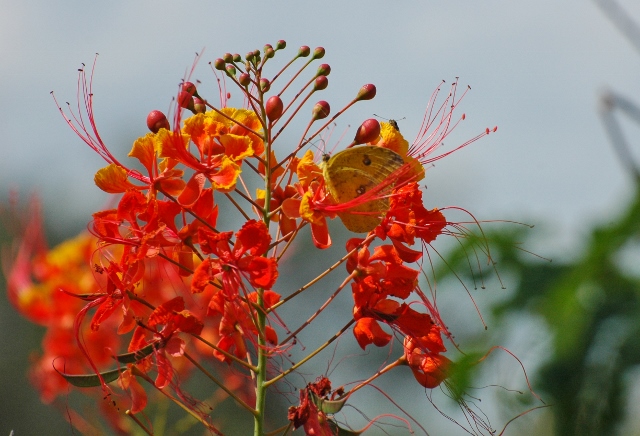Story and photo by Anita Westervelt, Texas Master Naturalist

It’s tree planting time in the Valley! An annual theme that means cooler temps in January and February make it more pleasant to dig in the garden. It also means it’s a good time to plant trees and shrubs. They establish better without the stress of the heat and drought of summer.
What you plant now will have a direct correlation on butterfly activity come summer and fall!
Judging from the busiest bushes in my yard last fall, two native plants that attracted the most butterflies were crucita and heliotrope.
Crucita, (Chromolaena odorata), also called fall-blooming mist flower, has purple flowers and blooms in late summer and fall.
Heliotrope, (Heliotropium angiospermum), also called scorpion tail, has white flowers and attractive bright green feathery foliage. It blooms most of the year and attracts the small butterflies. Both plants easily re-seed.
Although not native, Poinciana bush (Caesalpinia pulcherrima), also called pride of Barbados, is a beautiful flowering, nectar-rich shrub. A Valley favorite, it is popular in south Texas to San Antonio, south Florida, and along the California coast and southwest Arizona.
The vibrant, orange and yellow, intricately designed flowers, can provide hours of entertainment to a butterfly and hummingbird enthusiast. Upwards of 30 different species of butterflies have been documented visiting its flowers in the Rio Grande Valley. It’s a favorite of hummingbirds and bees, and the occasional hummingbird moth. Anoles like to camouflage themselves on the branches waiting to snag a tasty insect.
The flowers are similar to a jumbo-sized frilly orchid. Each flower has five orange petals with ruffled, yellow margins. Ten red stamens, about six inches long, extend from the flower and are tipped by red-gold anthers
Native plants generally are drought tolerant and have low water needs. They will establish in most of our Valley soils. Some exotics, like the Poinciana bush, will establish easily in the Valley in well-drained soil. Once established, Poinciana bush is drought and heat tolerant. It loves the Valley climate without showing aggressive or invasive tendencies, which is always a caution when considering non-native species.
The shrub quits blooming toward the end of fall. It can be pruned during December and January by trimming the dead wood or a more severe prune, by leaving only about four feet of the stem or stems, if it is multi-stemmed. Gloves are recommended; the branches have thorns.
Give this plant plenty of room as it can become a large shrub about 10 feet tall with nearly the same girth. Water well when planting and water a couple of times a week for the first three or four weeks.
Three or four nectar-rich plants are all you need to attract butterflies. Visit local garden centers and nurseries for recommendations. Native plants are available for sale at many local nature parks, or find a native plant grower by visiting this link: https://rgvctmn.org/rgv-plants/. A helpful Texas Parks and Wildlife Department download for Lower Rio Grande Valley butterfly native nectar plants is at the National American Butterfly Association link: https://www.naba.org/chapters/nabast/plants_info.pdf.